Woodeaton
Woodeaton or Wood Eaton is a village and civil parish about 4 miles (6.4 km) northeast of Oxford, England.
| Woodeaton | |
|---|---|
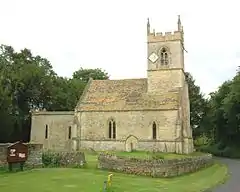 Holy Rood parish church | |
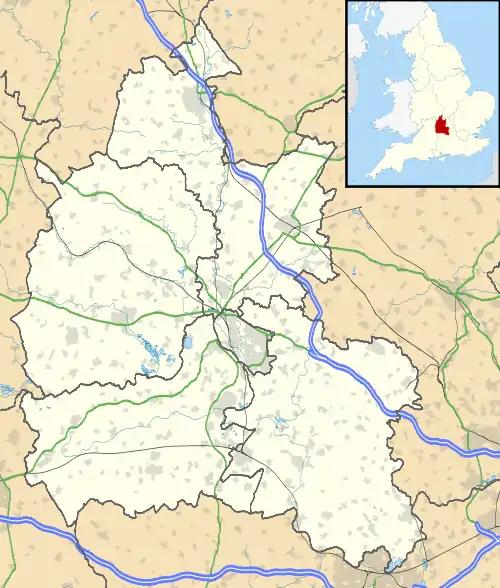 Woodeaton Location within Oxfordshire | |
| Population | 80 (2001 census)[1] |
| OS grid reference | SP5312 |
| Civil parish |
|
| District | |
| Shire county | |
| Region | |
| Country | England |
| Sovereign state | United Kingdom |
| Post town | Oxford |
| Postcode district | OX3 |
| Dialling code | 01865 |
| Police | Thames Valley |
| Fire | Oxfordshire |
| Ambulance | South Central |
| UK Parliament | |
Archaeology
There was a Romano-Celtic temple north of where the parish church now stands, and probably a Romano-British settlement and shrine as well.[2] The shrine was used successively by Roman pagans and Christians.[3]
A small square temple was built in the first century AD.[4] This was replaced with a more substantial building that had moulded stonework and decorated plasterwork, and a rectangular perimeter wall was added that enclosed an area around the temple building.[4]
Numerous notable bronze artefacts have been discovered at and around the site[4] and are now housed in the Ashmolean Museum in Oxford.[5] A sixth-century Anglo-Saxon pendant has also been found at the site, but the reason for its presence at a Roman site is not clear.[6]
Manor
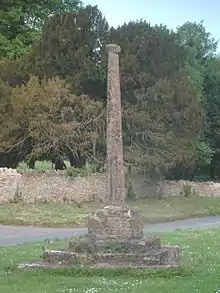
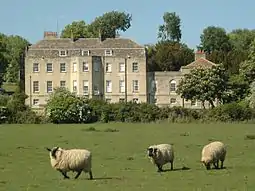
The Old English toponym was originally Eatun. By the 12th century it had become Wood Eaton, perhaps to distinguish it from Water Eaton just over 1 mile (1.6 km) to the west.[3]
The Domesday Book records that by 1086 the Norman nobleman Roger d'Ivry held the manor of Eaton. In about 1160 Helewis Avenel gave a virgate of land at Woodeaton to Eynsham Abbey. The Abbey had a grange and manor court house in Woodeaton, recorded in 1366, but no trace remains. The Manor remained with the abbey until the Dissolution of the Monasteries in 1538.[3]
At the centre of the village, by the village green, are the base and shaft of a 13th-century stone cross.[7] The cross is both a scheduled monument[8] and a Grade I listed building.[9]
After the Dissolution of the Monasteries in 1536 the manor of Woodeaton was bought and sold by two speculators in succession. Then in 1544 Richard Taverner (1505–75), the translator of Taverner's Bible, bought the manor. He retired to the village and had a manor house built in the 1550s,[3] and he is buried in Holy Rood churchyard. Woodeaton remained in the Taverner family until 1604.
The manor then passed through various hands until it was bought by the Nourse family from Middleton Keynes, Buckinghamshire somewhen between 1623 and 1625. In 1774 John Nourse, the last of the male line, died and left the manor to his daughter Elizabeth Weyland, wife of John Weyland.[3]
In 1775 Weyland had the old manor house demolished and the present Woodeaton Manor built. The new house has a modest exterior but in 1791 the architect Sir John Soane enhanced its main rooms with marble chimneypieces, added an Ionic porch of Coade stone, a service wing and an ornate main hall.[10]
The manor remained with the family until 1912 when Captain Mark Weyland sold the house and part of the land. Christ Church, Oxford now owns most of the former manor lands.[3]
Since 1950 Woodeaton Manor House has been an Oxfordshire County Council school for children with special educational needs.[11] The house is a Grade II* listed building.[12]
Parish church
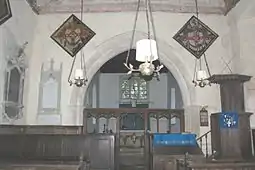
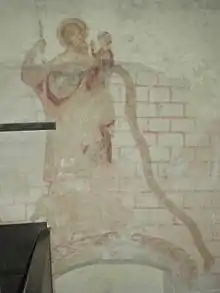
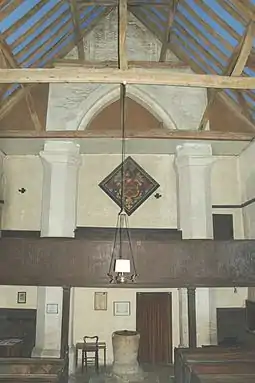

Woodeaton has had a parish church since the early or middle part of the 11th century,[13] when a Saxon timber one was built.[14] This was destroyed by fire by about AD 1080 at the latest.[14]
The present Church of England parish church of the Holy Rood originates from an early Norman stone church that was built between 1070 and 1120 to replace the destroyed Saxon one.[15] It was a small building, dominated by a western tower.[15] The original Norman layout is not entirely certain: there may have been a small nave east of the tower and an even smaller chancel beyond that, or the tower may have been a "tower-nave" with only a chancel to the east of it.[16]
In about 1180–1220 a late Norman south aisle and possible south chapel were added and in about 1200–50 the chancel was extended.[17] An Early English Gothic doorway in the south wall of the chancel is of a style that suggests a date of 1200–30.[18] Several Early English lancet windows in the chancel also date from this period.
The nave was rebuilt in about 1250–1300.[18] Later in the Middle Ages, the east and south walls of the chancel were rebuilt and were given late Perpendicular Gothic windows.[18] The eastern window in the south wall of the nave was also revised with Perpendicular tracery.[18]
The Perpendicular Gothic belltower was added in either the 14th[7][19] or 15th century.[3] Unusually the tower is built on columns erected inside the nave. This seems to be because the ground falls away west of the church to an extent that precluded building a tower conventionally to the west of the nave.[18]
The south porch was built in the 18th century.[3] In 2010 the church roof was restored, re-using many of the original Stonesfield slates.[20] Holy Rood church is a Grade I listed building.[19]
Bells and clock
The tower has a ring of five bells, all of which were cast by Henry II Bagley of Chacombe,[21] Northamptonshire in 1680.[22] Holy Rood has also a Sanctus bell cast by Richard Keene of Burford[21] in 1674.[22]
The tower has a turret clock similar to that at St Nicholas' Church, Islip, except that the iron bars of its frame are nutted together rather than wedged.[23] It may have been made in about 1700.[23] In the 1960s Dr. C.F.C. Beeson described it as "long disused, rusted".[23]
Furnishings and internal decoration
In the 14th century a large image of Saint Christopher was painted on the north wall inside the nave.[24] Restoration work in 2010 exposed remnants of an early 14th-century crucifixion scene above the rood beam over the chancel arch.[25]
Both the chancel and the nave have pews with 15th-century carved wooden bench ends.[7] The wooden screen in the chancel arch and some of the nave seating was added late in the 15th or early in the 16th century.[18] Reportedly there was a rood tympanum but this had been removed before 1846.[18]
In the 18th century the wooden pulpit, tester and reading desk were added,[7] along with the wooden panelling and west gallery.[3] Some timbers from the chancel screen tympanum seem to have been re-used in the 18th-century reading desk and pew floors.[18] There is also one box pew at the front of the nave, presumably for the manorial family.
Pioneer balloon flight
James Sadler, the first English balloonist, landed near the village after his first ascent from Christ Church Meadow in Oxford on 4 October 1784. He had flown a distance of about 6 miles (10 km) and reached a height of about 3,600 feet (1,100 m).
Amenities
Woodeaton is a small village with no shop or public house.
Woodeaton Wood is about 0.5 miles (800 m) southeast of the village, on the southwest side of Drun's Hill.
Demography
The 2011 Census incorporated its figures into an output area accordingly used to enlarge the civil parish definition of Elsfield to the south due to the small population of Woodeaton.[26]
References

- "Area selected: South Oxfordshire (Non-Metropolitan District)". Neighbourhood Statistics: Full Dataset View. Office for National Statistics. Retrieved 30 March 2010.
- "Romano-Celtic Temple & Probable Romano-British Settlement: Woodeaton, Islip, Oxfordshire". Roman-Britain.org. 28 September 2010. Retrieved 26 February 2012.
- Lobel 1957, pp. 309–317.
- "Site Name: Woodeaton". Oxfordshire's Historic Archives. Ashmolean Museum. June 2006. Retrieved 26 February 2012.
- Sherwood & Pevsner 1974, p. 854.
- "Anglo-Saxon Finds From Woodeaton". Anglo-Saxon Oxfordshire. Ashmolean Museum. Retrieved 26 February 2012.
- Sherwood & Pevsner 1974, p. 853.
- Historic England. "Woodeaton village cross (1015176)". National Heritage List for England. Retrieved 8 April 2012.
- Historic England. "Cross (1047563)". National Heritage List for England. Retrieved 8 April 2012.
- Sherwood & Pevsner 1974, pp. 853–854.
- Woodeaton Manor School
- Historic England. "Manor House (1369224)". National Heritage List for England. Retrieved 8 April 2012.
- Blair 1999, p. 221.
- Blair 1999, p. 228.
- Blair 1999, p. 232.
- Blair 1999, pp. 232–234.
- Blair 1999, p. 235.
- Blair 1999, p. 236.
- Historic England. "Church of the Holy Rood (1047562)". National Heritage List for England. Retrieved 8 April 2012.
- Anonymous 2010, p. 1.
- Baldwin, Sid (22 April 2011). "Bell Founders". Dove's Guide for Church Bell Ringers. Central Council of Church Bell Ringers. Retrieved 24 April 2011.
- Davies, Peter; Denton, Philip (9 November 2011). "Woodeaton Holy Rood". Dove's Guide for Church Bell Ringers. Central Council of Church Bell Ringers. Retrieved 14 December 2011.
- Beeson & Simcock 1989, p. 174.
- Marshall, Anne. "St. Christopher, Woodeaton, Oxfordshire". Painted Church. Retrieved 26 February 2012.
- Anonymous 2010, p. 2.
- Parish: Key Statistics: Population. (2011 census In particular the maps annexed to both definitions and data sets are identical. Retrieved 2016-05-04.
Sources and further reading

- Anonymous two-page leaflet in church (2010). Church of the Holy Rood Woodeaton Roof Project. Woodeaton: Holy Rood, Woodeaton Parochial Church Council.
- Bagnall Smith, Jean (1998). "The Romano-Celtic Temple at Woodeaton". Oxoniensia. Oxfordshire Architectural and Historical Society. LXIII: 147–185.
- Beeson, C.F.C. (1989) [1962]. Simcock, A.V. (ed.). Clockmaking in Oxfordshire 1400–1850 (3rd ed.). Oxford: Museum of the History of Science. p. 174. ISBN 0-903364-06-9.
- Blair, John (1998). "Archaeological Discoveries at Woodeaton Church". Oxoniensia. Oxfordshire Architectural and Historical Society. LXIII: 221–237.
- Goodchild, Richard; Kirk, Joan R. (1954). "More Votive Finds from Woodeaton, Oxfordshire". Oxoniensia. Oxford Architectural and Historical Society. XIX: 15–40.
- Jope, E.M. (1957). "A Fragment of Chain-Mail from the Romano-British Temple Site at Woodeaton". Oxoniensia. Oxford Architectural and Historical Society. XXII: 106–107.
- Jope, E.M; Hughes, D. (1940). "Blue Pigment of Roman Date from Woodeaton, Oxon". Oxoniensia. Oxford Architectural and Historical Society. V: 167.
- Kirk, Joan R. (1949). "Bronzes from Woodeaton, Oxon". Oxoniensia. Oxford Architectural and Historical Society. XIV: 1–45.
- Lobel, Mary D, ed. (1957). A History of the County of Oxford: Volume 5: Bullingdon Hundred. Victoria County History. pp. 309–317.
- Sherwood, Jennifer; Pevsner, Nikolaus (1974). Oxfordshire. The Buildings of England. Harmondsworth: Penguin Books. pp. 853–854. ISBN 0-14-071045-0.
External links
![]() Media related to Woodeaton at Wikimedia Commons
Media related to Woodeaton at Wikimedia Commons
Gallery
 Holy Rood: Norman tub font, probably late 11th century
Holy Rood: Norman tub font, probably late 11th century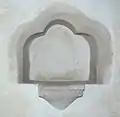 Holy Rood: cusped piscina
Holy Rood: cusped piscina Holy Rood: single-ended sedilium
Holy Rood: single-ended sedilium Holy Rood: medieval cusped niche
Holy Rood: medieval cusped niche Holy Rood: 15th-century pew end
Holy Rood: 15th-century pew end Holy Rood: beams and heraldic hatchments above the chancel arch
Holy Rood: beams and heraldic hatchments above the chancel arch Holy Rood: 18th-century pulpit and reading desk
Holy Rood: 18th-century pulpit and reading desk Holy Rood: monument to Anna Nourse (died 1669) and John Nourse (died 1708)
Holy Rood: monument to Anna Nourse (died 1669) and John Nourse (died 1708) Holy Rood: monuments to Dame Charlotte Johnstone (above, died 1813) and Lieutenant John Weyland (below, died 1882)
Holy Rood: monuments to Dame Charlotte Johnstone (above, died 1813) and Lieutenant John Weyland (below, died 1882) Holy Rood: monument to Trooper Albert Woodcock, Q.O.O.H. (died 1915)
Holy Rood: monument to Trooper Albert Woodcock, Q.O.O.H. (died 1915)
